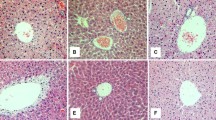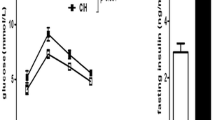Abstract
Purpose
Sleep apnea–hypopnea syndrome and its chronic intermittent hypoxia component may cause multi-system-targeted injury. The latest finding shows that liver is one of the injured organs. The purpose of the study is to observe the dynamic process of the influence that chronic intermittent hypoxia plays on rat liver enzyme, hepatic histology, and ultrastructure based on lipid disorders.
Methods
A total of 72 male Wistar rats were randomly divided into three groups. The control group was fed with a regular chow diet, the high fat group with a high fat diet, and the high fat plus intermittent hypoxia group with a high fat diet with a 7-h/day intermittent hypoxia treatment. Changes were observed in rat liver enzyme, hepatic histology, and ultrastructure of the three groups on the third, sixth, and ninth weeks, respectively. The liver paraffin sections were detected with myeloperoxidase.
Results
The liver function and structure of the control group were found to be normal; the liver enzyme level of the high fat group was significantly higher than that of the control group on the sixth and ninth weeks; and the liver enzyme level of the high fat plus intermittent hypoxia group was significantly higher than that of the control group and the high fat group on the third, sixth, and ninth weeks (all P < 0.01). Observed by a light microscope and a transmission electron microscope, the high fat group and the high fat plus intermittent hypoxia group were all characterized by nonalcoholic fatty liver disease: the high fat group was characterized by simple fatty liver on the third and sixth weeks and by steatohepatitis on the ninth week; the damage of the high fat plus intermittent hypoxia group was significantly more severe than that of the high fat group in all the monitoring points, characterized by steatohepatitis on the sixth week and by obvious liver fibrosis on the ninth week; the myeloperoxidase level of the high fat plus intermittent hypoxia group was significantly higher than that of the control group and the high fat group (all P < 0.01).
Conclusions
Under the conditions of high fat and intermittent hypoxia, the injury to the liver function, hepatic histology, and ultrastructure is more severe than that of the high fat group. The injury mainly was characterized by nonalcoholic fatty liver disease and becomes more severe with increased exposure time. Oxidative stress may play an important role in the mechanism.




Similar content being viewed by others
References
Shahar E, Whitney CW, Redline S, Lee ET, Newman AB, Javier Nieto F, O’Connor GT, Boland LL, Schwartz JE, Samet JM (2001) Sleep-disordered breathing and cardiovascular disease cross-sectional results of the Sleep Heart Health Study. Am J Respir Crit Care Med 163:19–25
Lavie L (2004) Sleep apnea syndrome, endothelial dysfunction, and cardiovascular morbidity. Sleep 27:1053–1055
Yaggi HK, Concato J, Kernan WN, Lichtman JH, Brass LM, Mohsenin V (2005) Obstructive sleep apnea as a risk factor for stroke and death. N Engl J Med 353:2034–2041
McNicholas WT, Bonsignore MR, Management Committee of EUCOST ACTION B26 (2007) Sleep apnoea as an independent risk factor for cardiovascular disease: current evidence, basic mechanisms and research priorities. Eur Respir J 29:156–178. doi:10.1183/09031936.00027406
Marin JM, Carrizo SJ, Vicente E, Agusti AG (2005) Long-term cardiovascular outcomes in men with obstructive sleep apnea–hypopnoea with or without treatment with continuous positive airway pressure: an observational study. Lancet 365:1046–1053
Chin K, Nakamura T, Takahashi K, Sumi K, Ogawa Y, Masuzaki H, Muro S, Hattori N, Matsumoto H, Niimi A, Chiba T, Nakao K, Mishima M, Ohi M, Nakamura T (2003) Effects of obstructive sleep apnea syndrome on serum aminotransferase levels in obese patients. Am J Med 114:370–376. doi:10.1016/S0002-9343(02)01570-X
Tanne F, Gagnadoux F, Chazouilleres O, Fleury B, Wendum D, Lasnier E (2005) Chronic liver injury during obstructive sleep apnea. Hepatology 41:1290–1296. doi:10.1002/hep.20725
Savransky V, Nanayakkara A, Vivero A, Li J, Bevans S, Smith PL, Torbenson MS, Polotsky VY (2007) Chronic intermittent hypoxia predisposes to liver injury. Hepatology 45:1007–1013. doi:10.1002/hep.21593
Savransky V, Bevans S, Nanayakkara A, Li J, Smith PL, Torbenson MS, Polotsky VY (2007) Chronic intermittent hypoxia causes hepatitis in a mouse model of diet-induced fatty liver. Am J Physiol Gastrointest Liver Physiol 293:G871–877. doi:10.1152/ajpgi.00145.2007
Norman D, Bardwell WA, Arosemena F, Nelesen R, Mills PJ, Loredo JS, Lavine JE, Dimsdale JE (2008) Serum aminotransferase levels are associated with markers of hypoxia in patients with obstructive sleep apnea. Sleep 31:121–126
Kallwitz ER, Herdegen J, Madura J, Jakate S, Cotler SJ (2007) Liver enzymes and histology in obese patients with obstructive sleep apnea. J Clin Gastroenterol 41:918–921. doi:10.1097/01.mcg.0000225692.62121.55
Mishra P, Nugent C, Afendy A, Bai C, Bhatia P, Afendy M, Fang Y, Elariny H, Goodman Z, Younossi ZM (2008) Apnoeic–hypopnoeic episodes during obstructive sleep apnoea are associated with histological nonalcoholic steatohepatitis. Liver Int 28:1080–1086. doi::10.1111/j.1478-3231.2008.01822.x
Polotsky VY, Patil SP, Savransky V, Laffan A, Fonti S, Frame LA, Steele KE, Schweizter MA, Clark JM, Torbenson MS, Schwartz AR (2009) Obstructive sleep apnea, insulin resistance, and steatohepatitis in severe obesity. Am J Respir Crit Care Med 179:228–234
Brunt E, Janney C, Di Bisceglie A, Neuschwander-Tetri B, Bacon B (1999) Nonalcoholic steatohepatitis: a proposal for grading and staging the histological lesions. Am J Gastroenterol 94:2467–2474
Kleiner DE, Brunt EM, Van Natta M, Behling C, Contos MJ, Cummings OW, Ferrell LD, Liu YC, Torbenson MS, Unalp-Arida A, Yeh M, McCullough AJ, Sanyal AJ, Nonalcoholic Steatohepatitis Clinical Research Network (2005) Design and validation of a histological scoring system for nonalcoholic fatty liver disease. Hepatology 41:1313–1321. doi:10.1002/hep.20701
Henrion J, Colin L, Schapira M, Heller FR (1997) Hypoxic hepatitis caused by severe hypoxemia from obstructive sleep apnea. J Clin Gastroenterol 24(4):245–249
Day CP, James OFW (1998) Steatohepatitis: a tale of two “hits”? Gastroenterology 114:842–845
Day CP, Saksena S (2002) Non-alcoholic steatohepatitis: definitions and pathogenesis. J Gastroenterol Hepatol 17:377–384. doi:10.1046/j.1440-1746.17.s3.31.x, http://www3.interscience.wiley.com/doiinfo.html
Ip MS, Lam B, Ng MM, Lam WK, Tsang KW, Lam KS (2002) Obstructive sleep apnea is independently associated with insulin resistance. Am J Respir Crit Care Med 165:670–676. doi:10.1164/rccm.2103001
Lavie L (2003) Obstructive sleep apnoea syndrome—an oxidative stress disorder. Sleep Med Rev 7:35–51. doi:10.1053/smrv.2002.0261
Lavie L, Vishnevsky A, Lavie P (2004) Evidence for lipid peroxidation in obstructive apnea. Sleep 27:123–128
Chen L, Einbinder E, Zhang Q, Hasday J, Balke CW, Scharf SM (2005) Oxidative stress and left ventricular function with chronic intermittent hypoxia in rats. Am J Respir Crit Care Med 172:915–920. doi:10.1164/rccm.200504-560OC
Suzuki YJ, Jain V, Park AM, Day RM (2006) Oxidative stress and oxidant signaling in obstructive sleep apnea and associated cardiovascular diseases. Free Radic Biol Med 40:1683–1692. doi:10.1016/j.freeradbiomed.2006.01.008
Solis Herruzo JA, Garcia Ruiz I, Perez Carreras M, Muñoz Yagüe MT (2006) Non-alcoholic fatty liver disease. From insulin resistance to mitochondrial dysfunction. Rev Esp Enferm Dig 98:844–863
Winterbourn CC, Kettle AJ (2004) Reactions of superoxide with myeloperoxidase and its products. Jpn J Infect Dis 57:S31–S33
Acknowledgments
The authors thank Ms. Hai-xian Yang and Ms. Yu-tong Gao of Tianjin Medical University for their excellent technical assistance.
Author information
Authors and Affiliations
Corresponding authors
Rights and permissions
About this article
Cite this article
Feng, Sz., Tian, Jl., Zhang, Q. et al. An experimental research on chronic intermittent hypoxia leading to liver injury. Sleep Breath 15, 493–502 (2011). https://doi.org/10.1007/s11325-010-0370-3
Received:
Revised:
Accepted:
Published:
Issue Date:
DOI: https://doi.org/10.1007/s11325-010-0370-3




